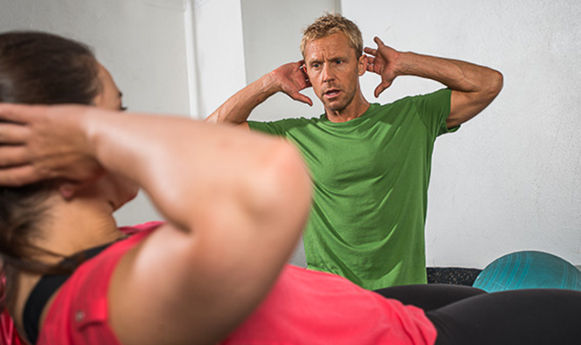
In 2010, the Department of Labor stated that there were more than a quarter of a million personal trainers and group exercise instructors in the United States. The Department of Labor predicts a 24 percent increase in that number by 2020, making personal training one of the fastest growing industries in the nation. According to a 2012 CNN report, high sense of service, independence, creativity and low stress levels were key aspects for the top 20 ranking of “personal trainer” in the list of “best jobs in the U.S.”
So where are these 250,000 satisfied fitness and wellness warriors doing their work? Although there are a limitless number of service delivery options, most fitness instructors are working in one or more of three basic arrangements: employee or staff member with an organization or private club; an independent contractor with a club; and owner of one’s own facility (see shaded box).
Association of Fitness Studios: Help for Studio Owners (and Those Considering Opening Their Own Studio)
Small studio owners, as well as fitness professionals who are thinking about opening their own studios, have a new source of support in the industry—the Association of Fitness Studios (AFS). Created to help “great fitness professionals become even greater business owners,” AFS offers a wide range of benefits to its members, including publications, money-saving programs, access to AFS Academy, programs and strategies to attract more customers, and opportunities to connect and interact with other studio owners.
AFS has three categories of members: Studios, Fitness Professionals and Associates. If you are interested in becoming a member, ACE-certified Fitness Professionals receive receive 10% off any AFS membership. Simply retrieve the promo code from the Professional Benefits & Discounts section of your My ACE Account and apply it at checkout.
To learn more about how you can tap the resources of this exciting new organization, click here.
So where are these 250,000 satisfied fitness and wellness warriors doing their work? Although there are a limitless number of service delivery options, most fitness instructors are working in one or more of three basic arrangements: employee or staff member with an organization or private club; an independent contractor with a club; and owner of one’s own facility (see sidebar).
Each of these employment options has certain advantages and disadvantages. It has been my experience over the last 25 years in the industry that experimenting with the first two scenarios is a good way to learn what arrangement best suits you. It’s also a great way to determine if you want to venture into the third scenario—studio ownership. As one’s preference become clearer and one’s goals evolve, it’s relatively easy to shift from one arrangement scenario to another.
For those of you who are contemplating studio ownership, I strongly suggest you take the time to answer the following six questions early on in the process to help you begin forming a clear and solid foundation on which to build out a comprehensive business plan. The questions below are not a finite list of considerations, but they will get you thinking about some of the most important ingredients you need to build a thriving fitness studio.
1. What flavor is your fitness?
Answering this question requires you to clarify the essence of your message and philosophy on how people improve and make changes in their lives. By clarifying your philosophy, you will begin framing the structure of what your facility, business model and customers will look like. Your choice on “flavor” will immediately begin helping you distinguish how your facility is going to be different from other options available to your potential clients. This question will ultimately help you develop the “core” look, feel and essence of your space.
My company is called Monumental Results. From the very beginning, at its core my company has been about educating, encouraging and inspiring clients to take small steps toward achieving grand life goals. People who are looking for the latest and greatest quick fixes will not be the ones who come through our doors, because we don’t serve that flavor of fitness. I have done my best to create a clean, high-quality environment that resonates the truth and the power of my “small steps over time” philosophy. It’s on the walls, it’s in the art, it’s on the website and it’s in the first conversation I have with every new client.
2. How do you intend to serve (deliver) your fitness?
Do you intend to provide private and semi-private sessions or do you intend to focus on group classes? Will you have employees, independent contractors or will it just be you? Will you offer other fitness and wellness services like yoga, Pilates or massage? These are just a few the areas you need to address to help clarify your vision for your studio. Also, identifying what kind of sessions you intend to offer will help you make a variety of other decisions including equipment, square footage needs and staffing/contractor arrangements.
A facility that focuses on one-on-one and semi-private sessions with one trainer on the floor at a time will likely require less square footage than a studio with more than one trainer working in the primary area at the same time or a studio that intends to offer group classes. However, because ownership requires doing a great many things besides working with clients, having at least one other professional utilizing the space while you are busy with the business side of things makes economic sense. Of course, this does add, at a minimum, a layer of managerial duties.
At Monumental Results I am the primary trainer and I do mostly one-on one and some semi-private sessions. I have chosen this option because the thing I enjoy most about our field is the quality relationships I build with individual clients. I have also brought on a small select group of experts as independent contractors, which means minimal managerial responsibilities, while still bringing in revenue when I am not working in the gym.
Offering other services besides fitness instruction (e.g., massage, yoga, Pilates) makes a studio more desirable to a wider cross-section of potential clients. Although there is something to be said for keeping things simple, offering more than just training will also expose your clients to other aspects of fitness that will likely serve them in developing a well-rounded fitness base.
In addition to our 700-square foot primary training space, we utilize a small annex building (approximate 500 square feet, where we have a rehab and massage room, a private yoga and Pilates area and my writing/podcast room. From both a range of service and space utilization perspective, this works quite well as frequently clients are being helped in the back space by another professional, while I’m training in the front space.
3. Who is your target customer?
In general, two central things will help you answer this question:
1. What type of clients do you want to work with?
2. What type of clients will want the flavor of fitness you are serving?
 Even in facilities where there is a very common population of clients, most trainers will inevitably work with clients from a variety of backgrounds with a wide range of goals. That said, by identifying the primary type of client you want to serve, it will be much easier to answer other “core” questions, such as appropriate location, and equipment and staffing needs.
Even in facilities where there is a very common population of clients, most trainers will inevitably work with clients from a variety of backgrounds with a wide range of goals. That said, by identifying the primary type of client you want to serve, it will be much easier to answer other “core” questions, such as appropriate location, and equipment and staffing needs.
Here are a few major demographic groups to consider.
- Youth versus adult versus geriatric
- Male versus female
- Athletic specialty versus general fitness
Although it’s important to be clear about who your target clients are, try be open to the unexpected and be able to utilize your space and equipment in ways that can potentially serve a variety of clients.
At Monumental Results, I built our studio to serve a broad range of clients. The equipment I selected, including a quality multi-cable machine, a Smith machine, dumbbells and instability devices, and a few of utilitarian aerobic machines, can meet the needs of most people whose primary objective is lifelong fitness.
To my pleasant surprise, we have seen an unanticipated population of clients over the age of 70, even 80 years old come through our doors. I would not have predicted that demographic based on my research, but it has been a welcomed bit of business and it ties in perfectly with the safe, sound programing and environment I created.
4. Where do you get it done?
Determining the best geographical location requires a few primary considerations:
1. Where are your existing customers willing to go?
2. How important is walk-by and drive-by traffic for generating new clients?
3. What part of town offers the right type of space at your right price?
One of the most important elements of making a sustainable financial transition into ownership is to start by bringing as many existing clients with you to your new facility as possible. Assuming you are not bound by restrictive agreements at your current place of employment, getting as many of your existing customers to go with you to your new studio will be a huge cash-flow advantage and will take some pressure off your need to create new customers right away.
The longer your relationship is with existing customers, the more flexible and willing to travel they are likely to be. I suggest having candid conversations with your key clients at appropriate times, framed in a respectful, reassuring way. But only have these conversations if you are very serious about studio ownership, as inquiring casually and not following through can create feelings of uncertainty for your clients.
Giving your clients a couple specific geographic areas that you’re considering is a good way to get meaningful feedback about their likelihood of moving on with you. Describe the upsides of your intended move and let them know their patronage is important to you and that you’d like to maintain the relationship. Bringing an established clientele to your new studio gives you a bit more freedom to pursue locations that may be less exposed to walk-by traffic, which usually means a lower cost-per-square-foot.
If you have a less-established clientele, focus on picking a location that your target customer will find and enjoy—and that you can afford. Classic storefront locations are helpful in bringing new clients in as long as the location you chose is frequented by the demographic you want to reach.
Comparison of Fitness Professional Employment Options
1. Employee/staff member of an organization like a YMCA or a private health club. This option will commonly mean:
- Classified as W2 employee to the organization
- Responsible to fitness director, head trainer or owner
- No usage fees associated with seeing clients
- Abundant client pipeline, largely from member base
- Lower hourly wage, likely with a capped amount
- No start up costs
- Low liability risks
- Strong job security
2. Independent contractor at private training facility(s). This option will commonly mean:
- Self employed or 1099 contractor, with self employment responsibilities
- No “boss”, but responsible to follow all guidelines of the facility
- Usage fees determined by facility
- Responsible for generating clients, though facility may assist
- Higher hourly wage, market limited cap only
- Low to moderate start up costs
- Moderate to high liability risks
- Job security rests in trainer’s ability to successfully obtain and retain clients
3. Owner of your own fitness facility. This option will commonly mean:
- Sole proprietor, S Corp, or LLC arrangement
- No boss, perhaps accountable to investors or partners
- Responsible for monthly rent and all operating expenses
- Solely responsible for generating clients
- Higher hourly wage, additional potential wages from leveraging staff/contractors
- Moderate to high start up costs
- High liability risk
- Job security rests in your ability to successfully manage all aspects of operations.
Finally, when it comes to location and affordability, there are two key aspects you need to consider:
1. The space you choose has to smoothly (not perfectly) serve the basic needs of your primary clients.
2. The price of the rental lease needs to be in line with a conservative estimate of projected revenue. Getting in an expensive lease that severely stretches your comfort zone and stresses you out on a monthly basis is a recipe for ill health and financial difficulty.
My first studio space was in the back of a slightly unusual office building that had very little walk-by traffic. Although the outside of the building was professional, it was not what you might think of as a traditional fitness facility. Inside, the space was well laid out, clean, private and affordable—a true oasis for my clients. That location served as a great transition from the work I had been doing prior to that as an independent contractor to studio ownership. During the seven years I spent at my first studio, I focused on growing my client base and developing my brand. The financial stress was relatively low due to a favorable lease agreement on the unique space. The central location, clean amenities and privacy made the slightly unusual industrial space a great first home for my Monumental Results clients.
5. What type of equipment and decor will maximize the experience of your clients?
Selecting the right quality and amount of equipment is a choice that will have a significant effect on the success of your business. From an exercise science perspective, it is clear that we actually need very little in the way of sophisticated equipment to help most people achieve their goals. Pushing, pulling, bending twisting, flexing and extending done in a variety ways will yield results. That said, it is important that the equipment you choose is, and is perceived by your clients to be, of a quality that is durable and will meet their training objectives. You don’t necessarily need to go deep into debt by purchasing the very top-of-the-line gym equipment, but you do need equipment that is clean, utilitarian and perceived to be of solid quality. The equipment you purchase should be an extension of your service and the brand you are attempting to build.
When it comes to décor, congruency and consistency are key. If you are creating an urban workout “barn,” for example, then some solid unfinished carpentry and cool motivational art would be great. If you are intending to operate in an upscale part of town and intend to earn top dollar for quality service, than it’s import that your décor gives the impression of refinement, and is of a quality equal to the value of your sessions. Neatness, cleanliness and tasteful décor set a tone of professionalism and should be in alignment with the image of your brand.
Dr. Michael Mantel, ACE’s senior fitness consultant for behavioral sciences, recommends being aware of what he calls “the crack in the window phenomenon.” He says that if clients (or potential clients) notice even a small crack in window (or any small thing that is broken or in disrepair), they are likely to wonder what else might be broken or not being addressed in your facility. Regular maintenance, neatness and attention to “cracks” go a long way in creating a facility that is seen as both polished and productive.
6. What are your revenue streams?

From a profitability perspective, a key and fundamental consideration is how to bring dollars into the studio. In small- to medium-sized fitness studios, it’s common practice for the owner to see clients and generate some amount of revenues. Even if you intend to be the major production engine at your facility, as an hourly worker one’s earning potential is limited by the number of hours you are willing and able to work and the rates you can charge. For that reason, it’s important to consider additional streams of revenue in building a lucrative fitness studio. Possible revenue streams include:
- At least one additional trainer as a staff member, or independent contractors that can utilize the facility
- Additional high-quality services like massage, Pilates or yoga
- Sales of equipment or products that are in line with your company’s values, within your scope of practice guidelines and that are covered under your insurance policy
- Public speaking; creating videos or writing books
- Selling advertising space on your website if you have a platform that can drive sales
Although the major part of my earnings continues to come from individual and small-group trainings, I have shifted my future growth strategies to focus more on motivational speaking, writing and consulting, and less from growth in my client load. Since the publication of my book, Going the Distance, three years ago, the source of my income has shifted substantially.
Having worked with individuals, small groups and teams for the past 25 years, these new platforms are helping to keep my enthusiasm high and learning curve steep, and are creating valuable income streams that helps meet my monthly ownership financial obligations.
Making the Leap to Studio Ownership
With a national obesity rate that continues to climb, a baby boomer generation that will be living longer and wanting to play harder than past generations, and a general population that now utilizes trainers more and more, the prospective client base for future trainers continues to broaden. I recommend you experiment with a variety of service delivery scenarios and, if you are drawn to ownership, start by answering these six questions as a way to begin creating a concrete plan that will help you create a business that is successful and satisfying.





 by
by 

 Even in facilities where there is a very common population of clients, most trainers will inevitably work with clients from a variety of backgrounds with a wide range of goals. That said, by identifying the primary type of client you want to serve, it will be much easier to answer other “core” questions, such as appropriate location, and equipment and staffing needs.
Even in facilities where there is a very common population of clients, most trainers will inevitably work with clients from a variety of backgrounds with a wide range of goals. That said, by identifying the primary type of client you want to serve, it will be much easier to answer other “core” questions, such as appropriate location, and equipment and staffing needs.

